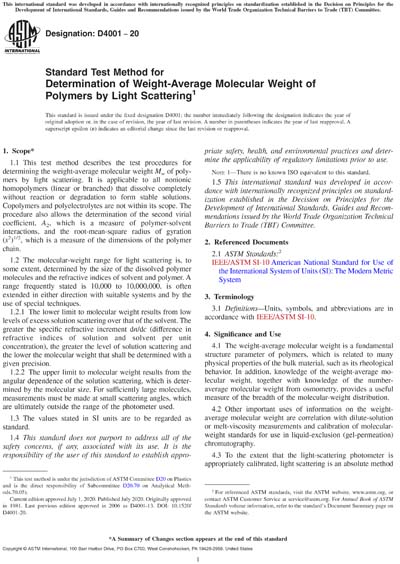Most recent
ASTM D4001-20
Standard Test Method for Determination of Weight-Average Molecular Weight of Polymers by Light Scattering
1.1 This test method describes the test procedures for determining the weight-average molecular weight Mw of polymers by light scattering. It is applicable to all nonionic homopolymers (linear or branched) that dissolve completely without reaction or degradation to form stable solutions. Copolymers and polyelectrolytes are not within its scope. The procedure also allows the determination of the second virial coefficient, A2, which is a measure of polymer-solvent interactions, and the root-mean-square radius of gyration (s2)1/2, which is a measure of the dimensions of the polymer chain.
1.2 The molecular-weight range for light scattering is, to some extent, determined by the size of the dissolved polymer molecules and the refractive indices of solvent and polymer. A range frequently stated is 10,000 to 10,000,000, is often extended in either direction with suitable systems and by the use of special techniques.
1.2.1 The lower limit to molecular weight results from low levels of excess solution scattering over that of the solvent. The greater the specific refractive increment dn/dc (difference in refractive indices of solution and solvent per unit concentration), the greater the level of solution scattering and the lower the molecular weight that shall be determined with a given precision.
1.2.2 The upper limit to molecular weight results from the angular dependence of the solution scattering, which is determined by the molecular size. For sufficiently large molecules, measurements must be made at small scattering angles, which are ultimately outside the range of the photometer used.
1.3 The values stated in SI units are to be regarded as standard.
1.4 This standard does not purport to address all of the safety concerns, if any, associated with its use. It is the responsibility of the user of this standard to establish appropriate safety, health, and environmental practices and determine the applicability of regulatory limitations prior to use.
Note 1: There is no known ISO equivalent to this standard.
1.5 This international standard was developed in accordance with internationally recognized principles on standardization established in the Decision on Principles for the Development of International Standards, Guides and Recommendations issued by the World Trade Organization Technical Barriers to Trade (TBT) Committee.
ASTM International [astm]

